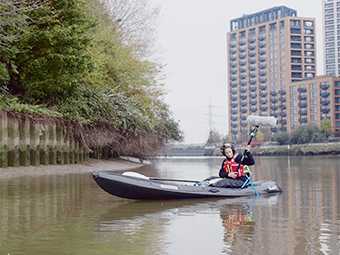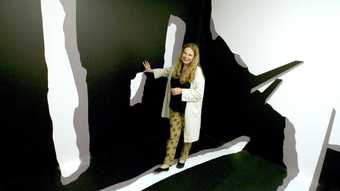[Sol Calero]: I'm doing this project and people might understand or not understand it but the fact that I'm here today, as a female Latin American artist, doing this is more important than anything really and I think that is what keeps me moving.
I'm Sol Calero, I was born in Venezuela. I'm an artist. I moved to Europe when I was 17 years old. When I started working, I think I was more like, in a way, angry. The idea of exoticisation, this sort of colourful aspect of the perception of Latin America by the Western eye and try to work with this. And make it even obvious in the installation as a way of presenting what you would think a Latin American artist would do and play with that.
We are here at Tate Liverpool and we are at the install of my next project called El Autobus and, at the moment, we're trying to build a bus inside the space.
The concept behind this installation is to talk about the perception that the traveller has before going to a place versus their reality once you arrive to this place.
I decided that if I wanted to be talking about Latin America in my work, I had to be traveling more to Latin America. And it was quite a shock, to be honest, because I found myself also going with a different perception of what the place was. You see, so also myself, I kind of had these preconceived ideas about Latin America too.
The way I start is like I have some orientative [sic] sketches which are not very clear but that's because I like to work in the space. For me is very important to compose when I'm in the space to really shake the space so people forget where they are, and to sort of erase the aspect of either the institution or the gallery.
I don't really like this idea of the artist as the genius. It's important to remember that behind every project and behind every artist there is a group of people helping. Especially in projects like this where we are producing all the work in the space.
When you come to a place or when you come to an exhibition and you have a preconceived idea of what you're going to see determines the way you think. So we're going to just fill the space with as many decorative elements that we can to shake whatever information you're going to come with.
I like to create spaces where people feel comfortable, it's just quite simple. You have a chair, people sit down. It's important to have time to process what you're seeing. In the audio, you'll have a description done by a tour guide of the places that we're going to visit on "this trip".
There's no references to real places, it's all made up. It's putting yourself in this sort of imaginary landscape that you'll never get to.
[Audio from artwork]: You will notice that we are now turning off the main roads and approaching the entrance of the Necropolis Huyotemanco. If you were all wondering wondering what the white things are everywhere on the sand well those are not rocks as some of you suggested. No no no, it's not minerals, it's not landscape formation, those are human bones!.
[Sol Calero]: I'm using these references that come from a much more surreal place. The way I remember growing up in Venezuela, for instance, it has nothing to do with the reality that is the country right now. I think I'm from a place, but that place doesn't exist anymore. When you have to integrate to a new place, you are forced to mix so much information that it becomes so unclear who you are.
You create a new scenario for yourself. I like to think that it's some sort of a utopia and see how I can transmit this sort of dreamy, foggy place. Not everyone is given the opportunity which is quite unfair no? Because if we were all making more art, if we were all thinking more creatively, it would be, I don't know, I like to think it's maybe a better world or at least we will be more open to think about things in a different way


